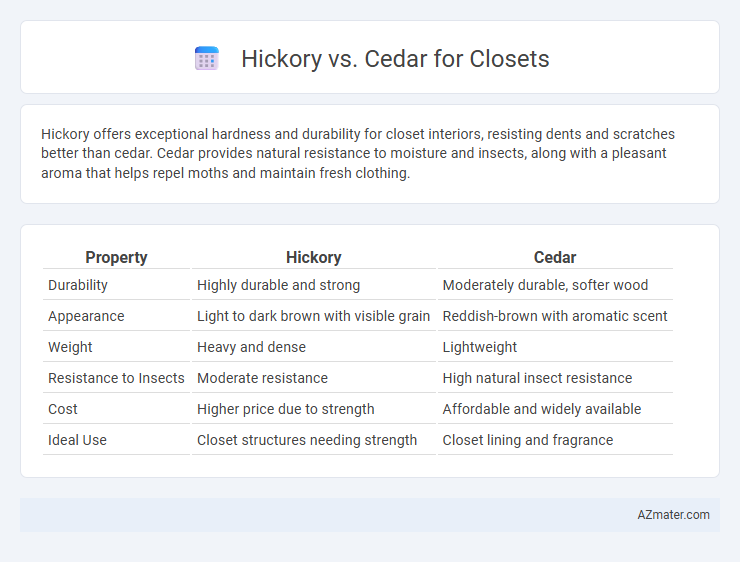Hickory offers exceptional hardness and durability for closet interiors, resisting dents and scratches better than cedar. Cedar provides natural resistance to moisture and insects, along with a pleasant aroma that helps repel moths and maintain fresh clothing.
Table of Comparison
| Property | Hickory | Cedar |
|---|---|---|
| Durability | Highly durable and strong | Moderately durable, softer wood |
| Appearance | Light to dark brown with visible grain | Reddish-brown with aromatic scent |
| Weight | Heavy and dense | Lightweight |
| Resistance to Insects | Moderate resistance | High natural insect resistance |
| Cost | Higher price due to strength | Affordable and widely available |
| Ideal Use | Closet structures needing strength | Closet lining and fragrance |
Introduction: Comparing Hickory and Cedar for Closets
Hickory and cedar are popular wood choices for closets due to their distinct characteristics and benefits. Hickory is known for its hardness, durability, and striking grain patterns, making it ideal for long-lasting closet structures and shelving. Cedar offers natural aromatic properties and insect-repellent qualities, making it perfect for maintaining fresh, pest-free storage spaces.
Wood Characteristics: Hickory vs Cedar
Hickory offers exceptional hardness and density, making it highly durable and resistant to dents and scratches, ideal for high-traffic closet use. Cedar is softer and lighter, known for its natural aromatic oils that repel insects and resist moisture, providing a pleasant scent and added protection against mold and mildew. Both woods feature distinct grain patterns, with hickory displaying a bold, varied texture, while cedar presents a smoother, reddish hue with fine, straight grains.
Durability and Strength Differences
Hickory offers superior durability and strength compared to cedar, making it ideal for closet construction where long-lasting support is essential. Hickory's dense grain structure provides enhanced resistance to dents and scratches, while cedar is softer but naturally resistant to moisture and insects, contributing to longevity in humid environments. Choosing hickory ensures a robust closet framework, whereas cedar brings moderate durability combined with natural aromatic properties.
Natural Aromas and Pest Resistance
Hickory offers a subtle, earthy aroma that helps create a warm, inviting closet environment while providing moderate pest resistance due to its dense grain. Cedar is renowned for its strong, natural fragrance that effectively repels moths and insects, making it an ideal choice for protecting clothing and textiles. Both woods provide natural pest deterrents, but cedar's aroma is more potent and long-lasting in closets.
Appearance and Grain Patterns
Hickory closets showcase a bold, rustic appearance with dramatic color contrasts ranging from light cream to dark brown, featuring pronounced and irregular grain patterns that add character and warmth. Cedar closets offer a smoother, more uniform aesthetic with a reddish hue and fine, straight grain patterns that provide a classic, elegant look while naturally repelling insects and odors. Choosing between Hickory and Cedar depends on the desired visual impact and the balance between striking texture and subtle refinement in closet design.
Maintenance and Longevity in Closets
Hickory wood offers exceptional durability and resistance to wear, making it a low-maintenance choice for closets that require longevity and frequent use. Cedar provides natural resistance to moisture and insects, ensuring closets remain fresh and protected from mold, but it may require periodic re-oiling to maintain its scent and appearance. Both woods deliver strong performance, but hickory's hardness offers superior scratch resistance, while cedar's aromatic properties enhance closet freshness over time.
Cost Comparison: Hickory vs Cedar
Hickory wood is generally more expensive than cedar due to its dense hardness and durability, which makes it a premium choice for closet construction. Cedar offers a more budget-friendly option with its moderate cost and natural resistance to moisture and insects, making it ideal for closet interiors. When comparing costs, hickory's higher price is balanced by its long-lasting strength, whereas cedar provides value through affordability and aromatic benefits.
Environmental Impact and Sustainability
Hickory and cedar differ significantly in environmental impact and sustainability for closet construction. Hickory, often harvested from faster-growing North American forests, supports sustainable forestry practices with high density and durability, reducing the need for frequent replacement. Cedar, valued for its natural resistance to pests and moisture, is typically sourced from slow-growing trees, raising concerns about deforestation and habitat disruption if not responsibly managed, although certified cedar options mitigate these effects.
Installation Considerations
Hickory closets require careful moisture control during installation due to their density and tendency to expand or contract, necessitating precise acclimation before fitting. Cedar closets benefit from natural resistance to insects and mold, easing installation in humid areas, yet installers must handle the softer wood gently to prevent dents or scratches. Both woods demand appropriate fastening techniques; hickory requires pre-drilling to avoid splitting, while cedar's lightweight nature allows for easier panel handling but emphasizes the need for secure anchoring to maintain long-term durability.
Which Is Best for Your Closet: Final Verdict
Hickory offers superior durability and resistance to dents, making it ideal for long-lasting closet structures, while cedar excels in natural aromatic properties and insect-repellent qualities that protect garments. Hickory's dense grain provides a smooth finish beneficial for shelves and drawers, whereas cedar's lightweight nature allows easier customization and installation. Choosing between hickory and cedar depends on whether you prioritize structural strength or odor control and pest resistance in your closet.

Infographic: Hickory vs Cedar for Closet
 azmater.com
azmater.com